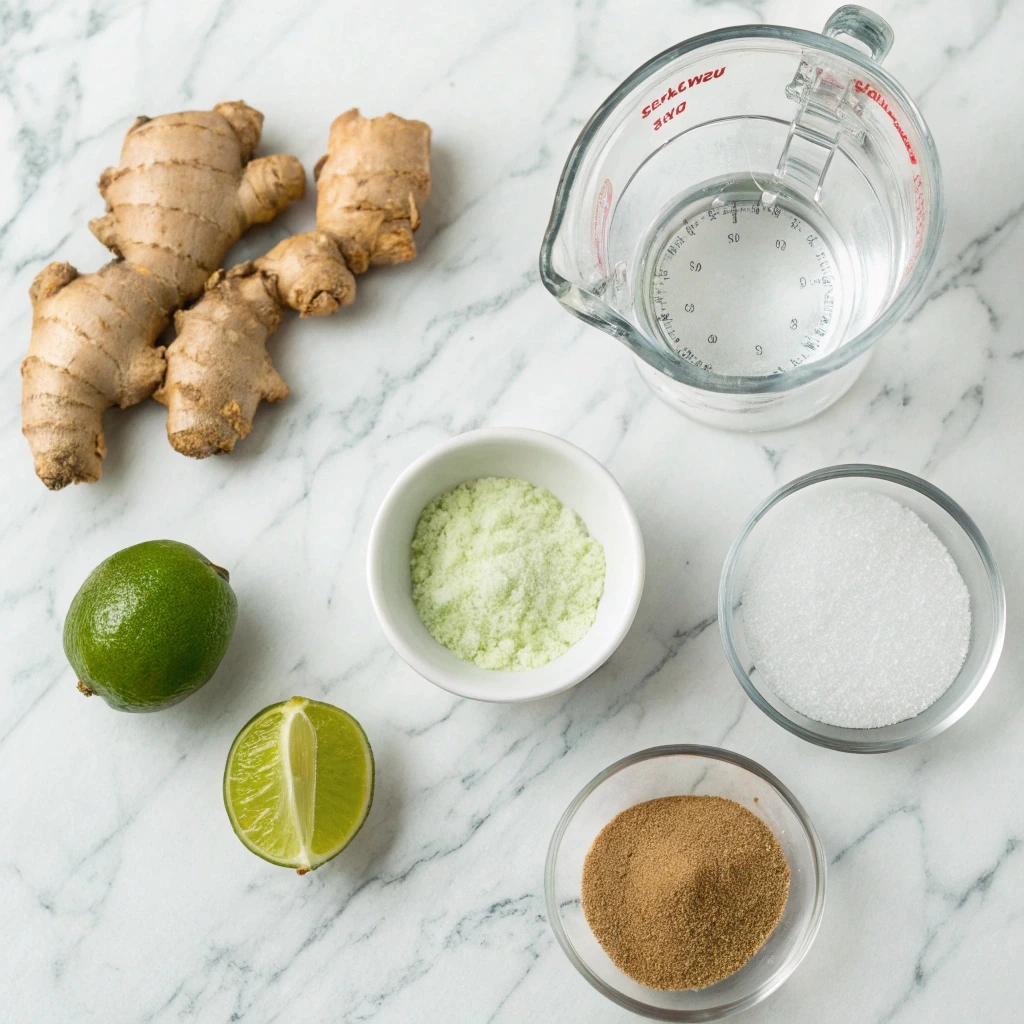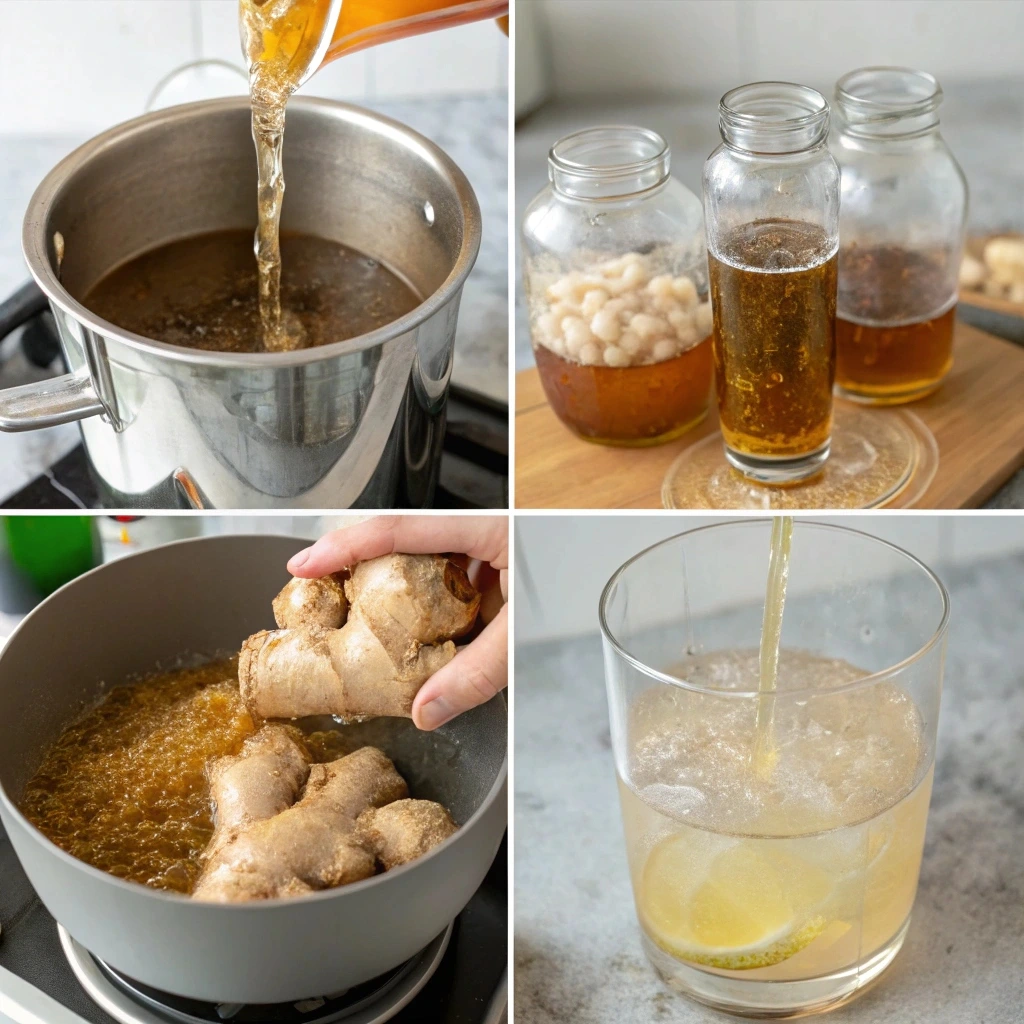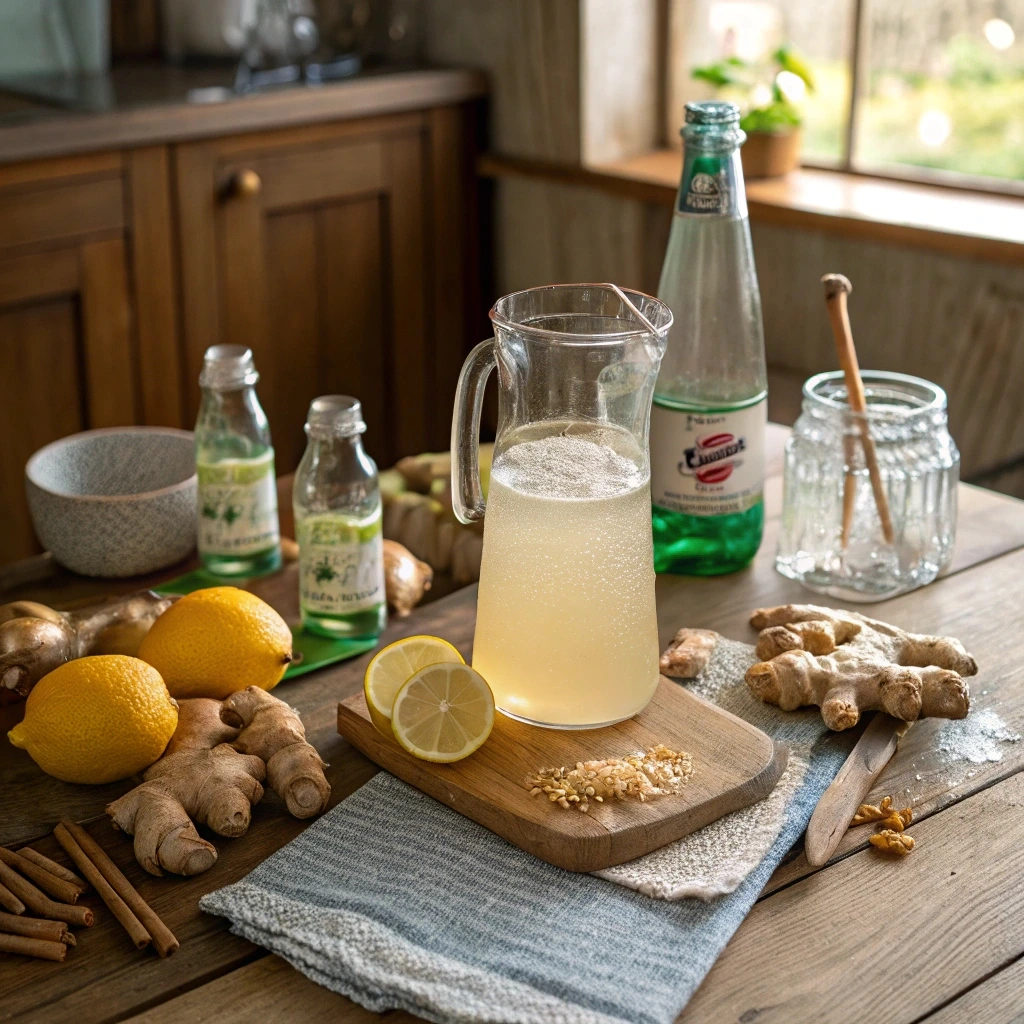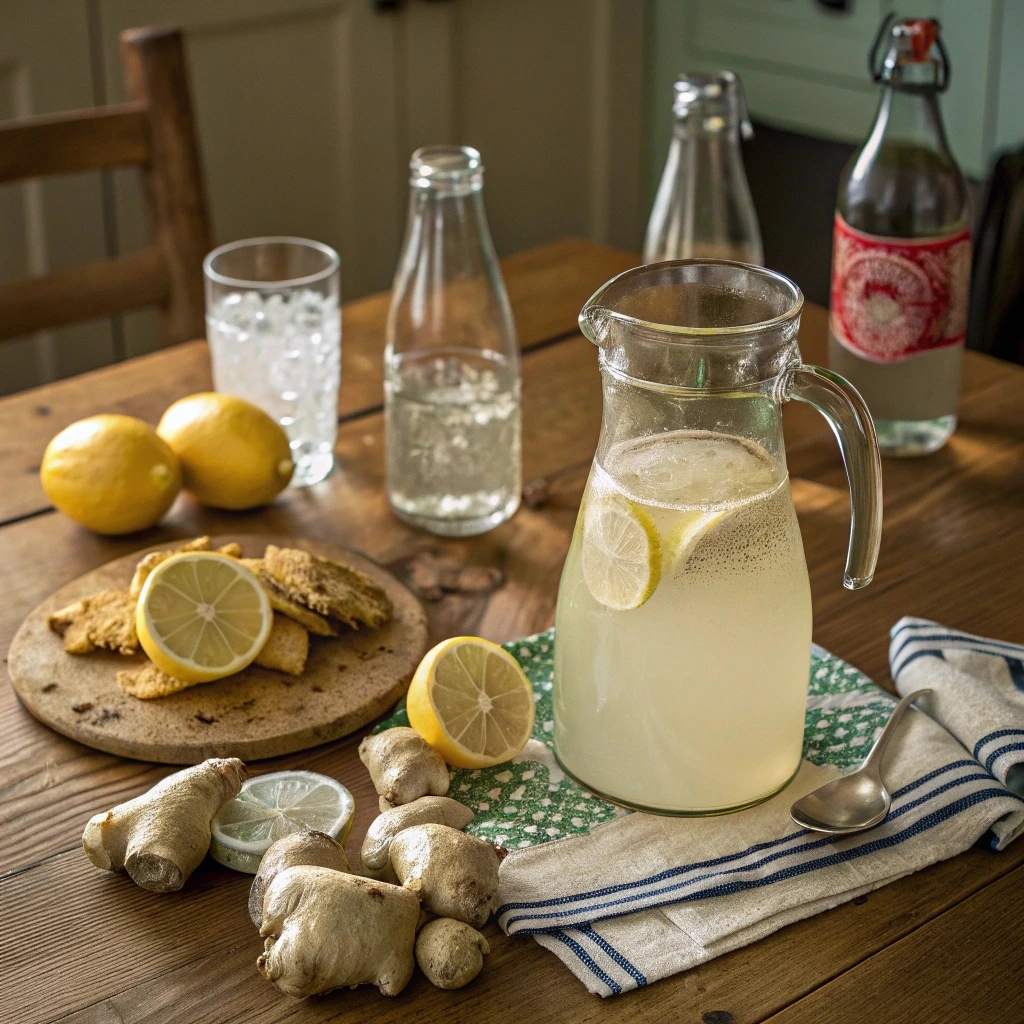Craving something fizzy, spicy, and naturally refreshing? You’re in the right place! This in-depth guide will walk you through everything you need to know about making your own ginger ale recipe from scratch—right in your kitchen.
We’ll dive into the history behind this bubbly favorite, talk about health perks, break down the must-have ingredients, and of course, share a tried-and-true homemade ginger ale recipe. Whether you’re going sugar-free, want a spicy twist, or are curious about fermenting it, we’ve got it covered.
Plus, you’ll learn how to fix common mistakes, serve it like a pro, and store it so it stays fresh longer. Stick around ‘til the end for a helpful FAQs section, and don’t miss the creative spin-offs to personalize your Ginger Ale Recipe like a boss!
Let’s get started by answering a question you might not have thought to ask: What exactly is ginger ale, and where did it come from?
Table of Contents
What Is Ginger Ale?
The Sparkling Story Behind Ginger Ale
Believe it or not, ginger ale has roots that go way back—like mid-19th-century Ireland back. The original version, sometimes called “golden ginger ale,” was a sweet, spicy drink invented by Irish apothecary Thomas Cantrell. It quickly gained popularity not just as a tasty beverage, but also as a natural remedy for indigestion and nausea.
Then came the “dry” style, thanks to Canadian pharmacist John McLaughlin in the early 1900s. His cleaner, milder version, later trademarked as Canada Dry, is what most of us sip on today when grabbing a commercial can.
Fast forward to now, and ginger ale is more than a soda—it’s a homemade tonic, a wellness drink, and a killer mixer for cocktails and mocktails alike.
Homemade vs. Store-Bought Ginger Ale
Sure, that bottled stuff from the store is convenient. But it usually comes loaded with artificial flavors, preservatives, and a shocking amount of sugar. Yikes.
Making a homemade ginger ale recipe not only gives you control over the ingredients, but it also lets you adjust the taste—more spice, less sweet, or even toss in something wild like clove or cardamom.
Moreover, the homemade version includes real fresh ginger, which means you’re getting all the digestive and anti-inflammatory perks that bottled brands often miss. For example, fresh ginger contains gingerol, a powerful compound that helps fight nausea and supports immunity.
So, is it worth making at home? Heck yes. It’s cheaper, healthier, and tastes way better. Therefore, if you’re looking to ditch store-bought soda, learning how to make your own ginger ale recipe is a bubbly step in the right direction.
Health Benefits of Ginger Ale
The Power of Ginger: Anti-inflammatory & Digestive Aid
Ginger isn’t just spicy—it’s powerful. This root has been used for centuries in traditional medicine, and now science backs up the hype. Fresh ginger, the star of every great ginger ale recipe, is loaded with compounds like gingerol, which have strong anti-inflammatory and antioxidant properties.
Therefore, drinking ginger ale made from real ginger can help soothe your stomach, ease nausea, and even reduce muscle pain. For example, many people reach for it when they’re battling motion sickness or recovering from the flu. Plus, it’s naturally caffeine-free—bonus!
However, not all ginger ales are created equal. Store-bought brands may use synthetic flavors or just a hint of ginger extract, which means you miss out on the good stuff. That’s why making your own ginger ale recipe is such a game-changer.
Is Homemade Ginger Ale Healthier Than Store-Bought?
In a word—yes! Homemade ginger ale gives you full control over every ingredient. You decide how much sugar to use, and you can even opt for healthier alternatives like honey or maple syrup. Moreover, there’s no high-fructose corn syrup or artificial additives in sight.
For those watching their sugar intake, homemade versions allow for easy swaps. You can also boost your drink with lemon or lime juice for added vitamin C and a zesty twist.
In addition, homemade ginger ale contains more natural ginger per serving, which means it’s not just tastier—it’s more functional. Whether you’re sipping it for enjoyment or wellness, a homemade ginger ale recipe is the smarter, healthier pick.
Key Ingredients in Ginger Ale

Ginger: Fresh vs. Powdered – Which One Is Better?
When it comes to making a ginger ale recipe that really pops, fresh ginger is the way to go. It delivers bold, spicy flavor and packs more of those health-boosting compounds like gingerol and shogaol. On the flip side, powdered ginger is more mellow, but it can work in a pinch if you’re out of fresh.
However, fresh ginger also offers more aromatic oils, which give your homemade drink that signature kick. Therefore, for the best results, always go fresh. If you like it spicier, just grate a bit more into your ginger syrup.
Sweeteners: Sugar, Honey, or Maple Syrup?
Every ginger ale needs a sweet base—and this is where you can customize. Traditional recipes use white sugar, but you can easily sub in honey, coconut sugar, or maple syrup for a deeper flavor and slightly healthier profile.
Moreover, natural sweeteners like honey add antimicrobial benefits. If you’re going the natural route, just remember to adjust quantities, as they can be sweeter than regular sugar.
Here’s a simple breakdown of the base ingredients for a classic ginger ale recipe:
| Ingredient | Quantity |
|---|---|
| Fresh ginger (grated) | ½ cup (about 4 oz) |
| Water | 2 cups (for ginger tea) |
| Sugar | 1 cup (or alternative) |
| Club soda | 2 cups (for fizz) |
| Lime juice (optional) | 1–2 tsp |
| Ice | As needed |
In addition, you can throw in cloves, cinnamon, or cardamom for a spiced-up twist. Play around and make it your own!
How to Make Ginger Ale at Home

Step-by-Step Ginger Ale Recipe Instructions
Ready to whip up your own sparkling, spicy goodness? This homemade Ginger Ale Recipe is simple, natural, and way tastier than store-bought stuff. With just a few fresh ingredients and a little patience, you’ll be sipping the good stuff in no time.
Let’s get started.
🧾 Ingredients:
| Ingredient | Quantity |
|---|---|
| Fresh ginger (grated) | ½ cup |
| Water (for ginger tea) | 2 cups |
| Sugar (or alternative) | 1 cup |
| Water (for syrup) | 1 cup |
| Club soda | 2 cups (chilled) |
| Lime juice (optional) | 1–2 teaspoons |
| Ice cubes | As needed |
Tip: Want an anti-inflammatory boost? Add a pinch of turmeric or check out this ginger turmeric tea recipe for more herbal inspiration!
Directions:
- Infuse the ginger water:
Boil 2 cups of water. Add the grated ginger and simmer for 5 minutes. Then, remove from heat and let it steep for another 20 minutes. Strain the liquid and discard the ginger solids. - Make the simple syrup:
In a separate pot, dissolve 1 cup of sugar in 1 cup of boiling water. Stir until fully dissolved. Let cool. - Mix it all together:
In a tall glass or pitcher, combine ½ cup ginger water, ⅓ cup syrup, and ½ cup club soda. Add lime juice for a citrusy twist, and don’t forget the ice!
Tips for Perfecting the Flavor Profile
- Too sweet? Cut back on syrup next time or add extra ginger water.
- Not spicy enough? Use more grated ginger or let it simmer longer.
- Want fizzier ginger ale? Use chilled soda water and mix just before serving.
Moreover, homemade ginger ale recipe blends beautifully with fresh fruits—try muddling strawberries or mint leaves for a refreshing twist.
And if you’re into more DIY drinks, stay tuned. This is just one of many fizzy recipes you’ll fall in love with!
Variations on the Classic Ginger Ale Recipe
Spicy Ginger Ale with Clove & Cardamom
Let’s spice things up! If you love bold flavors, adding spices like clove, cardamom, or even a tiny stick of cinnamon to your ginger syrup can take things to another level.
Simply add 1 clove and 2 cracked cardamom pods while simmering the ginger. Then strain them out with the ginger pieces. These warming spices don’t just smell amazing—they enhance the depth of flavor, too.
Moreover, this spiced-up twist works perfectly for colder months or when you’re looking for a more herbal, tea-like feel.
Fruity Infusions: Orange, Pineapple, or Raspberry
For something a little more playful, fruit infusions are where it’s at. For example, you can:
- Add orange zest or juice to the ginger water.
- Muddle fresh raspberries in the bottom of your glass.
- Blend pineapple juice with the club soda for tropical flair.
These fruity additions blend surprisingly well with the gingery base and give your ginger ale recipe that next-level appeal.
And don’t worry about messing up the mix—this recipe is super forgiving. Therefore, feel free to tweak and taste as you go!
For more delicious drink recipes, check out our article on Refreshing Lemon Mint Cooler to keep the hydration flowing with style!
Serving Suggestions & Storage
Creative Serving Ideas: Cocktails, Mocktails, and More
One of the coolest things about a homemade Ginger Ale Recipe is how flexible it is. You can keep it simple, or dress it up to impress guests at a party. Either way, it’s a win.
For example, serve it over crushed ice with a slice of lime or orange for a quick refreshment. Want to level up? Add a sprig of fresh mint or a splash of cranberry juice for a festive twist.
If you enjoy a bit of a kick, use it as a mixer in cocktails. A classic Dark ‘n’ Stormy or a Moscow Mule becomes even more exciting with homemade ginger ale. Moreover, if you’re skipping alcohol, mix your ginger ale with pomegranate juice or kombucha for a bold mocktail.
Therefore, whether you’re serving brunch, hosting dinner, or just need a drink that pops—this recipe fits the vibe.
How to Store Homemade Ginger Ale for Freshness
To keep your ginger ale recipe tasting its best, store the parts separately. Here’s how:
- Ginger water: Lasts 1 to 2 weeks in the fridge.
- Simple syrup: Can stay fresh for up to a month when sealed tight.
- Club soda: Best added just before serving for full fizz.
Don’t pre-mix the soda with the ginger and syrup unless you’re planning to drink it right away. Once it’s mixed, the bubbles won’t last long.
In addition, always use a clean jar or bottle with a lid to avoid any contamination. This way, your next glass will taste just as good as the first.

Troubleshooting Common Issues
Why Is My Ginger Ale Too Strong or Too Weak?
Sometimes your first batch might not hit the mark—and that’s okay! If your ginger ale recipe tastes too sharp, chances are you simmered the ginger too long or used too much. Try reducing the simmer time or cutting back a tablespoon or two of grated ginger next round.
On the other hand, if it’s too weak, add more ginger or let it steep longer. Also, using fresh ginger over powdered gives a stronger, brighter flavor.
In short, don’t be afraid to experiment. Taste as you go and tweak until it’s just right.
Fixing Carbonation Problems
Flat ginger ale? Ugh. That usually means one of two things: your club soda wasn’t fresh, or you mixed it too early. Always chill the soda before using, and only add it just before serving.
In addition, avoid shaking or stirring too much after mixing—carbonation is delicate and disappears fast. Therefore, pour gently and stir lightly to keep that fizz alive.
If you’re using homemade soda water, make sure your carbonation level is set high enough. And finally, serve it right after mixing for that crisp, bubbly experience every time.
FAQs About Ginger Ale
Can You Ferment Ginger Ale Naturally?
Yes, you absolutely can! While this guide focuses on a quick, non-alcoholic Ginger Ale Recipe, naturally fermented versions use a ginger “bug”—a mix of ginger, sugar, and water that ferments over a few days. As a result, you get a fizzy drink that’s rich in probiotics and has a more complex flavor.
However, fermentation takes time and patience. You’ll also need to monitor it closely to avoid over-fermentation. Therefore, if you’re just starting out, it’s smart to try the basic recipe first before diving into fermentation.
How Long Does Homemade Ginger Ale Last
It depends on how you store it. As mentioned earlier, keeping the ginger water and syrup separate helps extend freshness. When stored in airtight containers:
- Ginger water stays fresh for up to 1–2 weeks
- Simple syrup lasts for about 1 month
Once mixed with soda, enjoy your ginger ale recipe immediately for the best fizz. If you store a pre-mixed batch, it may go flat within hours. So, mix only what you plan to drink!
Is Ginger Ale Good for Nausea?
Absolutely. Ginger is well-known for easing nausea, whether from motion sickness, pregnancy, or a mild stomach bug. That’s one reason people reach for ginger ale when feeling queasy. However, homemade versions are far more effective, since they actually contain real ginger.
Can I Use Sparkling Water Instead of Club Soda?
Yes! Sparkling water is a great swap in any Ginger Ale Recipe. It’s lighter and often comes without added sodium, making it a cleaner option. In addition, flavored varieties like lemon or lime can add a subtle twist to your drink.

